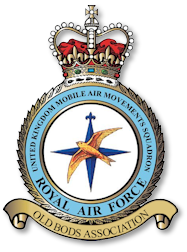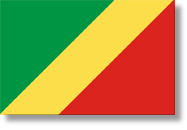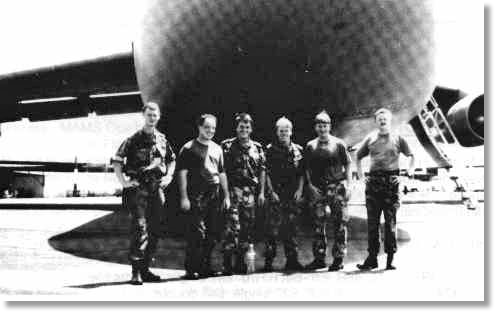


Zaire, one of the largest countries in Africa, had enjoyed a stable equilibrium for the past 30 years. During this period the country's President Mbuto had systematically siphoned $4 billion from his people. Rebels had slowly emerged from eastern Zaire in an attempt to replace the president with a new democracy. A bloody coup had been forecast and Operation Determinant was formulated to evacuate all FCO civilians should the situation require.
Planning had begun in March 1997 and the JFHQ deployed almost immediately, with this initial party was a UKMAMS team, which recovered within 3 days. After numerous false starts the main advance party deployed on 30 Apr 97, 3 x C130s arrived at Libreville, Gabon on 2 May.
Following on from this initial recce party, the main party began to arrive in earnest almost immediately. VC10s, C130s and a Tristar C2 ensured that the MAMS team had approximately 5 hours rest in the first 4 days! Transportation was limited and your life was taken in your hands on venturing onto the local roads! Welcome news was that all RAF personnel would be accommodated in one of the few hotels in the city, the down side being trying to fit 4 people in one bed!
Following on from this initial recce party, the main party began to arrive in earnest almost immediately. VC10s, C130s and a Tristar C2 ensured that the MAMS team had approximately 5 hours rest in the first 4 days! Transportation was limited and your life was taken in your hands on venturing onto the local roads! Welcome news was that all RAF personnel would be accommodated in one of the few hotels in the city, the down side being trying to fit 4 people in one bed!
The immediate task was to ensure that the deployed force, I PWRR, was aware of its operating area. Subsequently 2 sorties were flown each day to Brazzaville in the Congo, some 90 minutes flying time away. A plan had been formulated to evacuate refugees across the Congo from Kinshasa on boats, processed through a reception area and flown back to safe area for repatriation by civilian means. Having been split into two separate chalks, troops were instructed on their exact role within the evacuation and recovered back to Libreville the same day.
During this early part of the Operation, equipment was continually flown into Libreville and cross loaded onto C130s for onward transport to Brazzaville. Each aircraft was flat-floor loaded to ensure every pound of capacity could be utilised. UKMAMS personnel accompanied each flight into Brazzaville to liaise with both the senior Mover in-theatre and the deployed ATLO staff.
UKMAMS were also required as the in-theatre muscle due to the limited ACHE available. Libreville had the pick of ACHE i.e. a manual palletiser, however, even that outclassed ACHE available at Brazzaville which encompassed one 4 ton vehicle to back load into. Throughout the following weeks, sorties decreased to one per day, but callouts were common to ensure a continual high state of readiness. Call out to chocks was achieved in approximately 50 mins.
Throughout the Operation a variety of peace talks were arranged and subsequently abandoned due to the absence of one or other party. The threat heightened as rebels grew ever closer to the capital Kinshasa. Much of Africa had hoped that the president would resign peacefully and allow a calm transition of power, however, signals were that he would stay to the last.
Unsure of what the outcome may be, a variety of recovery plans were discussed and planned, as days wore on with much inactivity planning became more and more important. The other main issue facing the detachment was boredom through inactivity. Sport was difficult due to the oppressive daytime heat which averaged 36ºC - minimal exercise gave rise to an instant stream of sweat.
Finally, with almost no pre-warning, the President left Kinshasa and the city was taken peacefully. Within one hour the word was given to recover all deployed forces to UK. The two in-theatre C130s were fully loaded and had departed to Dakar inside 4 hours. A full recovery plan had been issued from PJHQ and airlift was arriving imminently. Within 24 hours PWRR had left theatre and then the movements problems really began.
It had been difficult to assess exactly what was in-theatre at any time and AT had to be utilised to its most effective. PJHO had planned to send a fleet of aircraft within the following 48 hours, but once the experts on the ground had replanned the recovery, a new recovery plan had been envisaged.
All in theatre freight was to be withdrawn from Libreville. So anything capable of being manhandled was recovered from Brazzaville by C130, cross-loaded onto pallets ready to backload onto USAF C5's. An Antonov 124 deployed to Brazzaville to recover all larger equipment (boats required for waterborne evacuation).
The US Air Force was tasked with providing two C5 cargo aircraft to complete the recovery from Libreville. With the assistance of a deployed US Air Force Movements team (complete with laptop loading schedules and preplanned loads), the full recovery was completed in 8 days. To show that US AT can be as reliable as our own, both C5s were delayed by 24 hours due to unserviceabilities. After flagging Dakar, the final remnants of Operation Determinant arrived back at Brize Norton in the early hours of 2nd June 1997.
It may be said that the operation was in fact a waste of resources, due to the final peaceful conclusion. However the RAF and indeed UKMAMS showed that again it could deploy to any country into any situation and provide a force capable of sustaining itself for an indefinite period should any extraction be required. During the Operation UKMAMS actually moved more than 1,000,000 lbs of freight. The majority of which was on flat floor aircraft
Yet again there was no press mention of UKMAMS presence in-theatre. The six man team provided an integral part of the operation and as the last people onto the aircraft from Libreville - it was indeed again ‘First in-Last out’!

UKMAMS detachment Brazzaville
Greg Saunders, Kenny Thompson, John Fairgreive,
Matt Rainer, Scouse Armitage Steve Walker
Greg Saunders, Kenny Thompson, John Fairgreive,
Matt Rainer, Scouse Armitage Steve Walker


